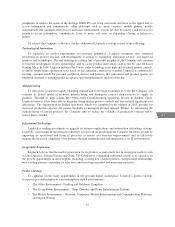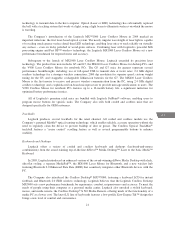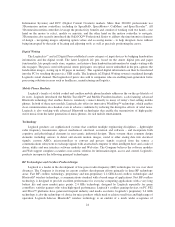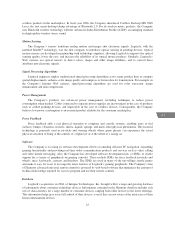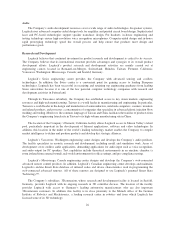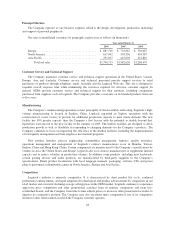Logitech 2006 Annual Report Download - page 83
Download and view the complete annual report
Please find page 83 of the 2006 Logitech annual report below. You can navigate through the pages in the report by either clicking on the pages listed below, or by using the keyword search tool below to find specific information within the annual report.
cordless products in the marketplace. In fiscal year 2006, the Company introduced Cordless Desktop MX 5000
Laser, the first smart desktop taking advantage of Bluetooth 2.0. For its wireless music products, the Company
uses Bluetooth wireless technology with the Advanced Audio Distribution Profile (A2DP), an emerging standard
for high-quality wireless stereo sound.
Motion Sensing
The Company’s sensors transform analog motion and images into electronic signals. Logitech, with the
patented Marble®technology, was the first company to introduce optical sensing in pointing devices. Optical
motion sensors are developed in partnership with technology suppliers, allowing Logitech to improve the optical
sensing quality, lower the cost, and increase the reliability of its optical mouse products. Similarly, Logitech’s
Web cameras use optical sensors to detect colors, shapes and other image attributes, and to convert these
attributes into electronic signals.
Signal Processing Algorithms
Logitech engineers employ sophisticated signal processing algorithms across many product lines to compute
spatial displacements, enhance color image quality and compress or format data for transmission. For example, in
the Company’s Internet Web cameras, signal-processing algorithms are used for color extraction, image
enhancement and data compression.
Power Management
The Company’s products use advanced power management, including techniques to reduce power
consumption when needed. Cables connected to separate power supplies are inconvenient in the case of products
such as corded pointing devices, and impossible in the case of cordless devices. Consequently, the Company
believes low power consumption is an essential product attribute for the consumer marketplace.
Force Feedback
Force feedback adds a real physical sensation to computer and console systems, enabling users to feel
surfaces, bumps, vibrations, textures, inertia, liquids, springs, and many other physical phenomena. This licensed
technology is primarily used in joysticks and steering wheels where game players can experience the actual
physical sensation of being at the controls of a fighter jet or at the wheel of a racing car.
Software
The Company is focusing its software development efforts on enabling efficient PC navigation, expanding
gaming functionality and providing real-time video communication products and services such as video calling
and video instant messaging. Also, the Company has developed software development kits, or SDKs, to enable
support for a variety of peripherals on gaming consoles. These include SDKs for force feedback joysticks and
wheels, mice, keyboards, cameras and headsets. The SDKs are used in many of the top-selling console games
and make it easy for users to leverage the latest features of Logitech’s gaming peripherals. The Company’s line
of Harmony advanced universal remote controls is powered by web-based software that minimizes the amount of
technical knowledge required for users to program and use their remote controls.
Database
Logitech’s acquisition, in 2004, of Intrigue Technologies, Inc. brought with it a large and growing database
of information about consumer technology devices. Information contained in the Harmony database includes rich
sets of characteristics for a large number of consumer devices, ranging from older devices to the latest offerings.
This information helps give users full control of their devices, even if they are not aware of the intricacies of their
home-entertainment devices.
25
CG
LISA






